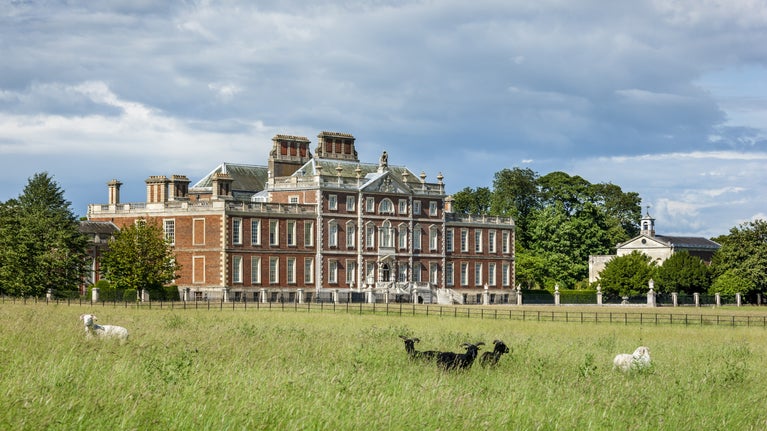
Discover more at Wimpole Estate
Find out when Wimpole Estate is open, how to get here, the things to see and do and more.

Come and explore the gardens at Wimpole where iconic garden and landscape designers including Charles Bridgeman, Robert Greening, Lancelot ‘Capability' Brown and Humphry Repton have all left their mark.
The gardens and parkland burst with colour and life in spring as Wimpole emerges from winter. Enjoy swathes of bright daffodils across the Pleasure Grounds, and in the walled garden our orchard transforms into a sea of blossom as the fruit trees bloom. In early spring, bulbs can be found across the estate; bright yellow aconites and delicate iris, both allowed to naturalise and spread. Later on, into April and May, fritillaria and tulips can be found too.
If you're looking to learn more about Wimpole's gardens or perhaps get some tips from our experts then why not join us for a Guided Garden Tour? Here you can learn about the great gardeners of the past who have helped shape Wimpole's pleasure grounds, discover this season's most notable new arrivals and hear about our plans for future growth in the gardens. Find out more below.

The four-and-a-half-acre walled garden at Wimpole was constructed of red handmade bricks in the 1790s by Philip Yorke, 3rd Earl of Hardwicke, with no expense spared. Even the walls were heated to keep peaches warm during the spring frosts.
When the National Trust took over its care in 1976, the 19th-century glasshouse had disappeared, and the garden was grassed over. Restoration began in the early 1990s, with pathways created, espalier fruit frames installed, 6000 box plants added, and the 18th-century Soane-designed ‘pinery-vinery’ reinstated in 1999.
Today the garden is a horticultural gem with a produce rich core surrounded by colourful herbaceous borders and seasonal cutting borders. The central area is split into four sections, the rotational quads, no-dig, soft fruit and the volunteer allotments. Following organic principles, the walled garden produces masses of crops such as potatoes, lettuce, carrots, beans, onions, garlic, cauliflower and more. Today over 20% of the garden’s produce is donated to the Harston Hub Foodbank, with the rest on sale at our visitor welcome centre or supplying The Old Rectory café.
First planted by Robert Greening in the 1750s to connect the Hall to his walled garden, the Pleasure Ground was substantially altered by garden designer William Emes, when he rebuilt the walled garden in the 1790s.
It was described in 1850 as having ‘picturesque, winding walks, leading a long way, admirably planted with groups and masses of the finest evergreens and deciduous trees'. There are also important views to and from the park, with the grounds occupying a pivotal position as the link between the hall and the park.
The Rejuvenation Project
The Pleasure Grounds rejuvenation project aims to restore and revitalize the Wimpole Grade I Listed Pleasure Grounds to a condition commensurate with their listed status. We’re planning to achieve this through the implementation of an appropriate climate adaptive planting scheme, the enhancement of our Spring bulb display and the creation of new seating and sensory experiences, ensuring the garden is welcoming for everyone, forever.

This area of garden was lost for a century and restored in 1996 in a Union Jack pattern of triangular beds edged with box hedging and planted with seasonal bedding and evergreens.
Look out for the best view of the Parterre, which is from the Chancellor's dressing room on the first floor of the hall. This was designed to be accessed via the Saloon steps on the north side of the house.
An award-winning design team was appointed in 2023 and is set to give Wimpole's parterre a sustainable and climate-resilient future with a transformative redesign.
Find out more about our parterre redesign project.
For a greener way of gardening we generate tons of homemade compost, use battery powered machinery wherever possible and harvest rainwater. We also use manure from our farm, peat-free compost and consciously plant for year-round pollinator attraction.

Find out when Wimpole Estate is open, how to get here, the things to see and do and more.

Built in 1794, Home Farm is the only in-hand farm of its kind in the National Trust. Unique to Wimpole Estate, it is a model for sustainable farming practices. A must see on your next visit, it is home to many rare-breed animals and the species of flora and fauna that make the estate an agricultural champion.

Stop for a bite to eat at one of the cafés or in the Old Rectory Restaurant at Wimpole.

Explore the acres of parkland at Wimpole, abundant with wildlife, flora and fauna; stroll across the open space, or head across the Chinese bridge to visit the Gothic folly.

Sustainable Landscape Foundation appointed to redesign Wimpole Estate parterre to ensure it is fit for the future Reimagined parterre will be more resilient to climate change and more biodiverse with a longer season of interest Trust’s Director of Gardens and Parklands says new design will mark a ‘bold, pioneering’ new chapter in the landscape’s history

Take a look at some of the important work that takes place at Wimpole Estate on a day-to-day basis, to look after this special place for everyone, for ever.

As part of the National Trust's Renewable Energy Investment Programme, Wimpole has reduced its dependence on fossil fuels in recent years. Here is what Wimpole has been doing to combat climate change on the estate.

From 18th-century water gardens and Arts and Crafts landscapes to intimate woodland gardens, there are so many places to discover.

Discover our gardeners’ top tips so you can make the most of your garden, plot or window box.